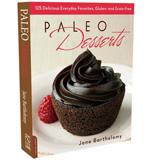 The easiest bread yet! This one-step bread tastes great in sandwiches or toast. Inspired by Old World European breads, just soak, blend, and bake. I used pumpkin, rye, buckwheat, and chia seeds, however you could use almost any grain or seed, gluten free or not, Paleo or not. There’s no yeast, no flour, no dairy, sugar or tree nuts. No kneading or waiting for yeast to rise. Just great flavor and high nutrition. The leavening is apple cider vinegar and soda. Eggs and chia help bind it together, but you’d never notice, as it tastes like authentic European bread. Try this bread! It’s a huge surprise! You’ll love it! Makes one 9 x 5 loaf, about 16 slices bread depending how you slice it.
The easiest bread yet! This one-step bread tastes great in sandwiches or toast. Inspired by Old World European breads, just soak, blend, and bake. I used pumpkin, rye, buckwheat, and chia seeds, however you could use almost any grain or seed, gluten free or not, Paleo or not. There’s no yeast, no flour, no dairy, sugar or tree nuts. No kneading or waiting for yeast to rise. Just great flavor and high nutrition. The leavening is apple cider vinegar and soda. Eggs and chia help bind it together, but you’d never notice, as it tastes like authentic European bread. Try this bread! It’s a huge surprise! You’ll love it! Makes one 9 x 5 loaf, about 16 slices bread depending how you slice it.
The Problem with Bread Flour – What to do about the belly?
Mix any flour with water and you get glue. Unfortunately all flours, even gluten-free flours, cause intestinal sluggishness. What’s that? Trapped food particles create a sticky rubbery coating that builds up in the intestines, leading to poor digestion and an expanded belly. This is sometimes called mucoid plaque, a mixture of mucus and finely ground processed food that creates an insoluble coating difficult to remove from the intestinal walls. The best resolution is to maintain clean intestines by eating healthy unprocessed foods, in which large pieces of plant fiber do the cleaning work. The Paleo diet eliminates all grains, and rightfully so. That’s because grains, and especially flours, cause buildup if we do not cultivate or prepare them properly. How can grains be used in a healthy way? Aha! I was hoping you would ask. Well, here are the 4 steps:
Step 1: Use soaked or sprouted whole grains or seeds, which have been rinsed of natural undigestible anti-nutrient saponin and lectin coatings. These grains can act as healthy cleaning agents in the intestines – if they have not been ground into flour.
Step 2: Use fresh grains. Whole dry grains keep for a very long time. However flours are perishable. After milling they begin to oxidize and become rancid. We tend to keep flours for an indeterminate time. Some experts say flours should not be used 4 – 6 months after grinding. I wonder how old was your flour when you bought it? Just take a look in your kitchen and ask how old is your flour? Rancid flour creates dangerous free radicals in the body that can lead to inflammation, heart disease, cancer, diabetes, dementia and more.
Step 3: Eat organic. Another intestinal challenge is caused by chemicals sprayed on all conventional grains. The best way to avoid chemicals is to choose organic. Organic grains are far superior to conventional grains, which are raised with herbicides and pesticides like Monsanto’s Glyphosate, a cause of cancer, diabetes, Alzheimer’s, autism, and many other common diseases. Organic costs a bit more, but you’ll get more nutrition for your dollar, and you’ll reap great savings in medical bills later on.
Step 4. Avoid flours altogether. Yes, skip flours and instead eat natural unprocessed whole grains that have been soaked. While this may sound extreme, all flours when mixed with a little water make wonderful wallpaper paste, even gluten-free flours. Mix any flour with a little water, add sugar and fat, and you have a sticky substance resembling the modern fast food diet. By avoiding all commercial flour products, pasta, bread, crackers, and sweets, there’s no way mucoid plaque can build in your intestines. Just use my free recipes here on this site! Let whole food nourish you while it keeps you clean inside!
This recipe sidesteps all the adverse effects of grains by using whole, organic whole grain, soaked and blended into a delicious bread.
Ingredients
- 3 large eggs at room temperature 165g out of the shell
- 1 1/4 cups (230 g) raw organic whole grain. I used half rye berries and half untoasted buckwheat groats, soaked 8 - 20 hours (overnight), well drained
- 3 tablespoons unfiltered apple cider vinegar
- 6 tablespoons olive or coconut oil melted but not hot
- 1 1/2 teaspoons unprocessed salt
- 2 tablespoons raw honey
- 1 teaspoon baking soda
- 1 1/2 tablespoons fennel seed, coarsely ground
- 1/2 cup (168 g) whole chia seeds. For a darker bread use black chia seeds.
- 2/3 cup whole pumpkin seeds
Instructions
- Preheat oven to 350º F. Line a 9 x 5 loaf pan with parchment paper so it hangs over the sides like handles. I secure it with photo clips.
- In any blender, add the eggs and soaked grain. very well drained, vinegar, oil, salt, and honey. Blend well, but do not liquefy it utterly. We want some crunchy texture in our bread, right?
- Add soda, fennel, chia seeds, and blend. The mixture will begin to thicken.
- Add pumpkin seeds and mix very briefly so they’re still in big chunks. Pour batter into the pan quickly, as the rising action has started.
- Bake a 9 x 5 pan 40 to 45 minutes. Remove from the oven and allow to cool 30 minutes to 1 hour. Slice and enjoy. This bread slices better when chilled.





No Replies to "Best Blender Bread"